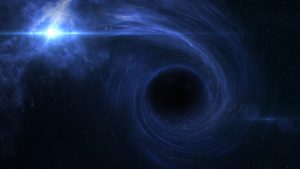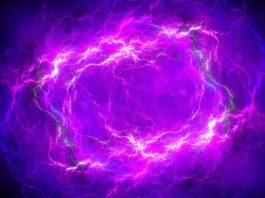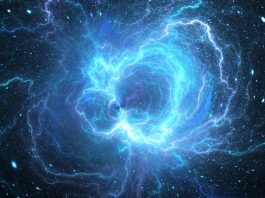An international team of researchers is studying the jet structure of the brightest gamma-ray burst of all time to determine why its afterglow remained visible for so long after the event.
When scientists detected the gamma-ray burst called GRB 221009A on 9 October 2022, it was named the brightest-of-all-time (BOAT).
Produced by the collapse of a highly massive star and the subsequent birth of a black hole, the event was witnessed as an immensely bright flash of gamma rays. This was then followed by a slow-fading afterglow of light across frequencies.
Now, months after the burst was detected, scientists studying the brightest explosion have found that the unusual structure of the jet of material expelled during the event may explain its extreme nature. It may also show why its afterglow remained visible for so long after it was detected.
The findings of the study, ‘A structured jet explains the extreme GRB 221009,’ are published in Science Advances.
What are gamma-ray bursts and how are they formed?
Gamma-ray bursts are the most violent and energetic explosions in the Universe. They release the same amount of energy in just a few seconds that the Sun produces over its entire lifetime.
Scientists believe that they are formed when a massive star runs out of fuel. Without a force to resist its own gravity, the core of the star collapses into a black hole, releasing a massive amount of energy. This energy spews into space as two jets of gamma rays shoot in opposite directions.

The brightest gamma-ray burst, GRB 221009A, was formed this way, resulting from the collapse of a massive star into a black hole.
The unique jets of GRB 221009A
The research team found that GRB 221009A’s jet exhibited a narrow core with wide-sloping wings. This is different from the types of jets seen in gamma-ray bursts produced by other cataclysmic events.
Scientists believe that it may be why GRB 221009A’s multi-wavelength glow was seen for months after the explosion.
The team also discovered that the initial burst was angled directly at Earth, dragging a large amount of stellar material in its wake.
Dr Hendrik Van Eerten from the Department of Physics at the University of Bath co-led the theoretical analysis of the afterglow.
He said: “Other researchers working on this puzzle have also come to the conclusion that the jet was pointed directly at us – much like a garden hose angled to spray straight at you – and this definitely goes some way to explain why it was seen so brightly.”
What remained a puzzle, however, was that the edges of the jet could not be seen.
“The slow fade of the afterglow is not characteristic of a narrow jet of gas, and knowing this made us suspect there was an additional reason for the intensity of the explosion, and our mathematical models have borne this out.
“Our work clearly shows that the GRB had a unique structure, with observations gradually revealing a narrow jet embedded within a wider gas outflow where an isolated jet would normally be expected.”
What made this gamma-ray burst wider than normal?
The researchers have a theory as to why the brightest gamma-ray burst ever was wider than usual events.

© shutterstock/IgorZh
Dr Van Eerten explained: “GRB jets need to go through the collapsing star in which they are formed, and what we think made the difference, in this case, was the amount of mixing that happened between the stellar material and the jet, such that shock-heated gas kept appearing in our line of sight all the way up to the point that any characteristic jet signature would have been lost in the overall emission from the afterglow.
“Our model helps not just to understand the BOAT, but also previous brightness record holders that had astronomers mystified about their lack of jet signature. These GRBs, like other GRBs, must be directed straight towards us when they happen, as it would be unphysical for that much energy to be expelled in all directions at once.
“An exceptional class of events appears to exist that are both extreme and manage to mask the directed nature of their gas flow. Future study into the magnetic fields that launch the jet and into the massive stars that host them should help reveal why these GRBs are so rare.”
The findings will fuel future studies of gamma-ray bursts
In the future, the scientists hope that the study’s results will help to create simulations of gamma-ray burst structures.
“GRB 221009A represents a massive step forward in our understanding of gamma-ray bursts, and demonstrates that the most extreme explosions do not obey the standard physics assumed for garden variety gamma-ray bursts,” said Brendan O’Connor, George Washington University graduate student and lead study author.
“GRB 221009A might be the equivalent Rosetta stone of long GRBs, forcing us to revise our standard theories of how relativistic outflows are formed in collapsing massive stars.”
“For a long time, we have thought about jets as being shaped like ice cream cones,” added Alexander van der Horst, associate professor of physics at GW and study co-author.
“However, some gamma-ray bursts in recent years, and in particular the work presented here, show that we need more complex models and detailed computer simulations of gamma-ray burst jets.”
O’Connor concluded: “The exceptionally long GRB 221009A is the brightest GRB ever recorded and its afterglow is smashing all records at all wavelengths. Because this burst is so bright and also nearby, we think this is a once-in-a-thousand-year opportunity to address some of the most fundamental questions regarding these explosions, from the formation of black holes to tests of dark matter models.”









